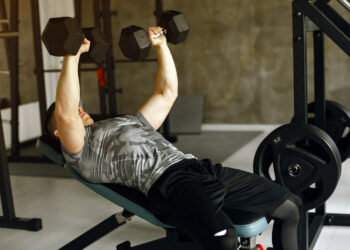The cable pulldown is one of the most commonly performed exercises that you’ll see at any gym. And that’s for good reason. It’s excellent for developing your lats and back muscles in general, plus it’ll muscle to the arms. Having a muscular back make you look more aesthetic and improves other all other compound lifts.
In this exercise guide, we’ll explain the muscles involved, how-to, tips, variations, and how to incorporate the cable pulldown in your training routine.
Here’s a guide to the cable pulldown…
How To Do The Cable Pulldown
If you want to maximize the effectiveness of this exercise, then it must be down properly. Here are step-by-step instructions of the cable pulldown.
- Sit on the machine bench and adjust the leg support padding accordingly.
- Choose your weight and grip the long bar with hands slightly wider than shoulder-width.
- Pull your shoulders down and lean slightly back.
- Drive your elbows down and back to pull the bar down to mid-chest.
- Slowly reverse the motion until you feel a slight stretch in your lats but do not allow your head to sink down into your shoulders.
Cable Pulldown Tips
- Use a thumbless grip to better mentally engage the lats.
- Do not lean too far back to effectively maximize engagement. Lean back slightly just to allow the bar to pass your chin.
- Never allow your head to sink down into your shoulders. Keep your shoulders down even during the negative portion of the exercise where the arms are extended overhead.
- Choose a weight that you can handle. Never lift beyond your means as this is dangerous and reduces the effectiveness of the exercise.
Related: The 8 Best Lat Exercises For A Bigger, Stronger Back
Muscles Worked
The cable pulldown works several muscle groups of which we’ve given a brief description of below.
Level Up Your Fitness: Join our 💪 strong community in Fitness Volt Newsletter. Get daily inspiration, expert-backed workouts, nutrition tips, the latest in strength sports, and the support you need to reach your goals. Subscribe for free!
- Latissimus dorsi – Covering a large portion of the back both in length and width, the lat muscles perform their best the arms are positioned overhead like when performing pull-ups and pulldowns.
- Deltoid Posterior – The rear delts are not excluded from pulling movements as they attach to the shoulder blade and assist in pulling the arms behind the body.
- Infraspinatus – The master rotator cuff muscles, infraspinatus is a thick triangle shaped muscle that externally rotates the upper arm and contributes to stabilization of the shoulder joint.
- Teres Major – Playing its own role, the teres major of the upper back adducts the arm at the shoulder or brings it in from an abducted position.
- Teres Minor – Like the infraspinatus, the teres minor is involved in the function of your rotator cuff muscles that move and stabilize the shoulder.
- Trapezius Lower Fibers – Many movements require you to pull your shoulder blades down. It’s the lower section of trapezius muscle fibers that assist in scapular depression.
- Trapezius Middle Fibers – Just above the lower traps fibers are the middle traps, pulling the scapula back and together, not up or down.
- Brachialis – As an elbow flexor the brachialis is stronger than the biceps, especially when the forearm is pronated (palms facing downwards). Located beneath or hidden to the biceps, brachialis has a large cross sectional area going from the upper arm down through the forearm.
- Brachioradialis – The brachioradialis take up more space in the forearm than than the brachialis and biceps. It’s active in all movements of the arm including bending the upper and lower arm and twisting the forearm.
3 Pulldown Variations
The cable pulldown will never go out of style as it’s extremely effective for its intended purpose. But there are variations that may be even more effective for developing the upper posterior chain muscles.
Single-arm pulldown
Single-side training is a must. The single-arm pulldown allows for a deeper contraction of the target muscles due to being able to bring the elbows down even further behind the back. Not to mention, it’s useful for identifying and correcting left to right imbalances.
Level Up Your Fitness: Join our 💪 strong community in Fitness Volt Newsletter. Get daily inspiration, expert-backed workouts, nutrition tips, the latest in strength sports, and the support you need to reach your goals. Subscribe for free!
Training one side at a time is referred to as unilateral training because it involves more stabilization, activation of the core muscles, and it simply offers benefits that bilateral training (affecting both sides) does not. You may not be able to lift as much weight overall but the advantages are clear.
Close-grip cable pulldown
Whether you use two single-grip handles or a v-bar, this variation of the pulldown will allow you to lift more weight which is necessary for building muscle and strength. This variation involves keeping your arms close to your sides and may emphasize the rhomboids and traps a bit better than using a wide grip.
How To Incorporate The Cable Pulldown Into Your Training Routine
For your best back development, it’s recommended to include a few different exercises that emphasize the various muscles that make up the back. The cable pulldown is typically utilized to emphasize the lat muscles. Although, it will engage the other back muscles as well.
Sets/reps
We recommend doing 3-4 sets of around 6-20 reps of the cable pulldown and no more than 2-3 sets of another pulldown or pull-up type exercise. Then, of course, you’ll do 2-3 other exercises to complete your back training.
But ultimately, your sets and reps will depend on your overall training volume.
Wrapping Up
The cable pulldown is here to stay and it’ll make an excellent addition your back training regime. It’s a great lat and back building exercise and we recommend it. But you don’t have to just stick to the straight bar variation. Include the other variations that we included as well in addition to any other variations that you feel may be good for your development.
Interested in measuring your progress? Check out our strength standards for Pull Ups.








